Guggenheim Museum, New York
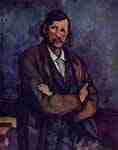
The Watchmaker, Paul Cézanne
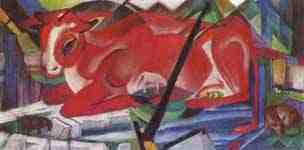
The Worlds Cow, Franz Marc
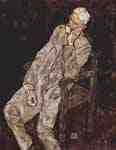
Portrait of Johann Harms, Egon Schiele
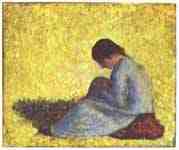
On a meadow sitting farmer girl, Georges Seurat
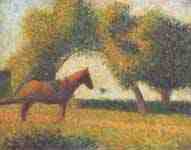
La Charette Attelée, Georges Seurat
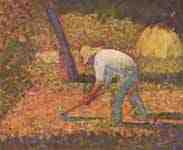
Peasant with a hoe, Georges Seurat
----
Fine Art Prints | Greeting Cards | Phone Cases | Lifestyle | Face Masks | Men's , Women' Apparel | Home Decor | jigsaw puzzles | Notebooks | Tapestries | ...
----
The Solomon R. Guggenheim Museum, often referred to as The Guggenheim, is an art museum located at 1071 Fifth Avenue on the corner of East 89th Street in the Upper East Side neighborhood of Manhattan, New York City. It is the permanent home of a continuously expanding collection of Impressionist, Post-Impressionist, early Modern and contemporary art and also features special exhibitions throughout the year. The museum was established by the Solomon R. Guggenheim Foundation in 1939 as the Museum of Non-Objective Painting, under the guidance of its first director, the artist Hilla von Rebay. It adopted its current name after the death of its founder, Solomon R. Guggenheim, in 1952.
In 1959, the museum moved from rented space to its current building, a landmark work of 20th-century architecture. Designed by Frank Lloyd Wright, the cylindrical building, wider at the top than the bottom, was conceived as a "temple of the spirit". Its unique ramp gallery extends up from ground level in a long, continuous spiral along the outer edges of the building to end just under the ceiling skylight. The building underwent extensive expansion and renovations in 1992 (when an adjoining tower was built) and from 2005 to 2008.
The museum's collection has grown organically, over eight decades, and is founded upon several important private collections, beginning with Solomon R. Guggenheim's original collection. The collection is shared with the museum's sister museums in Bilbao, Spain, and elsewhere. In 2013, nearly 1.2 million people visited the museum, and it hosted the most popular exhibition in New York City.[1]
History
Early years and Hilla Rebay
Solomon R. Guggenheim, a member of a wealthy mining family, had been collecting works of the old masters since the 1890s. In 1926, he met artist Hilla von Rebay,[3] who introduced him to European avant-garde art, in particular abstract art that she felt had a spiritual and utopian aspect (non-objective art).[3] Guggenheim completely changed his collecting strategy, turning to the work of Wassily Kandinsky, among others. He began to display his collection to the public at his apartment in the Plaza Hotel in New York City.[3][4] As the collection grew, he established the Solomon R. Guggenheim Foundation, in 1937, to foster the appreciation of modern art.[4]
The Museum of Non-Objective Painting
Albert Gleizes, 1915, Composition pour Jazz, oil on cardboard, 73 x 73 cm
The foundation's first venue for the display of art, the "Museum of Non-Objective Painting", opened in 1939 under the direction of Rebay, in midtown Manhattan.[5] Under Rebay's guidance, Guggenheim sought to include in the collection the most important examples of non-objective art available at the time by early modernists such as Rudolf Bauer, Rebay, Kandinsky, Piet Mondrian, Marc Chagall, Robert Delaunay, Fernand Léger, Amedeo Modigliani and Pablo Picasso.[3][4][6]
By the early 1940s, the foundation had accumulated such a large collection of avant-garde paintings that the need for a permanent museum building had become apparent.[7] In 1943, Rebay and Guggenheim wrote a letter to Frank Lloyd Wright asking him to design a structure to house and display the collection.[8] Wright accepted the opportunity to experiment with his organic style in an urban setting. It took him 15 years, 700 sketches, and six sets of working drawings to create the museum.
In 1948, the collection was greatly expanded through the purchase of art dealer Karl Nierendorf's estate of some 730 objects, notably German expressionist paintings.[6] By that time, the foundation's collection included a broad spectrum of expressionist and surrealist works, including paintings by Paul Klee, Oskar Kokoschka and Joan Miró.[6][9] After Guggenheim's death in 1949, members of the Guggenheim family who sat on the foundation's board of directors had personal and philosophical differences with Rebay, and in 1952 she resigned as director of the museum.[10] Nevertheless, she left a portion of her personal collection to the foundation in her will, including works by Kandinsky, Klee, Alexander Calder, Albert Gleizes, Mondrian and Kurt Schwitters.[9] The museum was renamed the Solomon R. Guggenheim Museum in 1952.[10]
Design
Rebay conceived of the space as a "temple of the spirit" that would facilitate a new way of looking at the modern pieces in the collection. She wrote to Wright that "each of these great masterpieces should be organized into space, and only you ... would test the possibilities to do so. … I want a temple of spirit, a monument!"[11][12] The critic Paul Goldberger later wrote that, before Wright's modernist building, "there were only two common models for museum design: Beaux-arts Palace ... and the International Style Pavilion."[13] Goldberger thought the building a catalyst for change, making it "socially and culturally acceptable for an architect to design a highly expressive, intensely personal museum. In this sense almost every museum of our time is a child of the Guggenheim."[13]
The museum's atrium
From 1943 to early 1944, Wright produced four different sketches for the initial design. While one of the plans (scheme C) had a hexagonal shape and level floors for the galleries, all the others had circular schemes and used a ramp continuing around the building. He had experimented with the ramp design on the house he completed for his son in 1952, the David & Gladys Wright House in Arizona. Wright's original concept was called an inverted "ziggurat", because it resembled the steep steps on the ziggurats built in ancient Mesopotamia.[14] His design dispensed with the conventional approach to museum layout, in which visitors are led through a series of interconnected rooms and forced to retrace their steps when exiting.[15] Wright's plan was for the museum guests to ride to the top of the building by elevator, to descend at a leisurely pace along the gentle slope of the continuous ramp, and to view the atrium of the building as the last work of art. The open rotunda afforded viewers the unique possibility of seeing several bays of work on different levels simultaneously and even to interact with guests on other levels.[16]
At the same time, before settling on the site for the museum at the corner of 89th Street and Fifth Avenue, overlooking Central Park, Wright, Rebay and Guggenheim considered numerous locations in Manhattan, as well as in the Riverdale section of the Bronx, overlooking the Hudson River.[17] Guggenheim felt that the site's proximity to Central Park was important; the park afforded relief from the noise, congestion and concrete of the city.[14] Nature also provided the museum with inspiration.[17] The building embodies Wright's attempts "to render the inherent plasticity of organic forms in architecture."[15] The Guggenheim was to be the only museum designed by Wright. The city location required Wright to design the building in a vertical rather than a horizontal form, far different from his earlier, rural works.[14]
The spiral design recalled a nautilus shell, with continuous spaces flowing freely one into another.[18] Even as it embraced nature, Wright’s design also expresses his take on modernist architecture's rigid geometry.[18] Wright ascribed a symbolic meaning to the building's shapes. He explained, "these geometric forms suggest certain human ideas, moods, sentiments – as for instance: the circle, infinity; the triangle, structural unity; the spiral, organic progress; the square, integrity."[19] Forms echo one another throughout: oval-shaped columns, for example, reiterate the geometry of the fountain. Circularity is the leitmotif, from the rotunda to the inlaid design of the terrazzo floors.[17]
The building's surface was made out of concrete to reduce the cost, inferior to the stone finish that Wright had wanted.[20] Wright proposed a red-colored exterior, which was never realized.[21] The small rotunda (or "Monitor building", as Wright called it) next to the large rotunda was intended to house apartments for Rebay and Guggenheim but instead became offices and storage space.[22] In 1965, the second floor of the Monitor building was renovated to display the museum's growing permanent collection, and with the restoration of the museum in 1990–92, it was turned over entirely to exhibition space and christened the Thannhauser Building, in honor of one of the most important bequests to the museum.[23] Wright’s original plan for an adjoining tower, artists’ studios and apartments went unrealized, largely for financial reasons, until the renovation and expansion.[16][24] Also in the original construction, the main gallery skylight had been covered, which compromised Wright’s carefully articulated lighting effects. This changed in 1992 when the skylight was restored to its original design.[20]
Museum under construction in photo taken on Nov. 12, 1957
Sweeney years and completion of construction
In 1953, the foundation's collecting criteria expanded under its new director, James Johnson Sweeney. Sweeney rejected Rebay's dismissal of "objective" painting and sculpture, and he soon acquired Constantin Brâncuși's Adam and Eve (1921), followed by works of other modernist sculptors, including Joseph Csaky, Jean Arp, Calder, Alberto Giacometti and David Smith.[6] Sweeney reached beyond the 20th century to acquire Paul Cézanne's Man with Crossed Arms (c. 1899).[6] The same year, the foundation also received a gift of 28 important works from the Estate of Katherine S. Dreier, a founder of America's first collection to be called a modern art museum, the Société Anonyme. Dreier had been a colleague of Rebay's. The works included Little French Girl (1914–18) by Brâncuși, an untitled still life (1916) by Juan Gris, a bronze sculpture (1919) by Alexander Archipenko and three collages (1919–21) by German Hanoverian Dadaist Schwitters. It also included works by Calder, Marcel Duchamp, El Lissitzky and Mondrian.[9] Among others, Sweeney also acquired the works of Alberto Giacometti, David Hayes, Willem de Kooning and Jackson Pollock.[25]
Sweeney oversaw the last half dozen years of the construction of the museum building, during which time he had an antagonistic relationship with Frank Lloyd Wright, especially regarding the building's lighting issues.[26][27] The distinctive cylindrical building turned out to be Wright's last major work, as the architect died six months before its opening.[28] From the street, the building looks like a white ribbon curled into a cylindrical stack, wider at the top than the bottom, displaying nearly all curved surfaces. Its appearance is in sharp contrast to the typically rectangular Manhattan buildings that surround it, a fact relished by Wright, who claimed that his museum would make the nearby Metropolitan Museum of Art "look like a Protestant barn."[28] Internally, the viewing gallery forms a helical spiral ramp climbing gently from ground level to the skylight at the top.[28]
Criticisms and opening of the building
An interior view of the museum on a busy day
Even before it opened, the design polarized architecture critics.[28][29] Some believed that the building would overshadow the museum's artworks.[7][30][31] "On the contrary", wrote the architect, the design makes "the building and the painting an uninterrupted, beautiful symphony such as never existed in the World of Art before."[30] Other critics, and many artists, felt that it is awkward to properly hang paintings in the shallow, windowless, concave exhibition niches that surround the central spiral.[28] Prior to the opening of the museum twenty-one artists signed a letter protesting the display of their work in such a space.[28] Historian Lewis Mumford summed up the opprobrium:
"Wright has allotted the paintings and sculptures on view only as much space as would not infringe upon his abstract composition. ... [He] created a shell whose form has no relation to its function and offered no possibility of future departure from his rigid preconceptions. [The promenade] has, for a museum, a low ceiling – nine feet eight inches [limiting painting size. The wall] slanted outward, following the outward slant of the exterior wall, and paintings were not supposed to be hung vertically or shown in their true plane but were to be tilted back against it. ... Nor [can a visitor] escape the light shining in his eyes from the narrow slots in the wall."[32]
On October 21, 1959, ten years after the death of Solomon Guggenheim and six months after the death of Frank Lloyd Wright, the Museum first opened its doors to large crowds.[33][34] The building became widely praised[35][36][37] and inspired many other architects.[14]
The skylight in the center of the museum
Messer years
Thomas M. Messer succeeded Sweeney as director of the museum (but not the foundation) in 1961 and stayed for 27 years, the longest tenure of any of the city's major arts institutions' directors.[38] When Messer took over, the museum's ability to present art at all was still in doubt due to the challenges presented by continuous spiral ramp gallery that is both tilted and has non-vertical curved walls.[39] It is difficult to properly hang paintings in the shallow, windowless exhibition niches that surround the central spiral: canvasses must be mounted raised from the wall's surface. Paintings hung slanted back would appear "as on the artist's easel". There is limited space within the niches for sculpture.[28]
Almost immediately, in 1962, Messer took a risk putting on a large exhibition that combined the Guggenheim's paintings with sculptures on loan from the Hirshhorn collection.[39] Three-dimensional sculpture, in particular, raised "the problem of installing such a show in a museum bearing so close a resemblance to the circular geography of hell", where any vertical object appears tilted in a "drunken lurch" because the slope of the floor and the curvature of the walls could combine to produce vexing optical illusions.[40] It turned out that the combination could work well in the Guggenheim's space, but, Messer recalled that at the time, "I was scared. I half felt that this would be my last exhibition."[39] Messer had the foresight to prepare by staging a smaller sculpture exhibition the previous year, in which he discovered how to compensate for the space's weird geometry by constructing special plinths at a particular angle, so the pieces were not at a true vertical yet appeared to be so.[40] In the earlier sculpture show, this trick proved impossible for one piece, an Alexander Calder mobile whose wire inevitably hung at a true plumb vertical, "suggesting hallucination" in the disorienting context of the tilted floor.[40]
The next year, Messer acquired a private collection from art dealer Justin K. Thannhauser for the museum's permanent collection.[41] These 73 works include Impressionist, Post-Impressionist and French modern masterpieces, including important works by Paul Gauguin, Édouard Manet, Camille Pissarro, Vincent van Gogh and 32 works by Pablo Picasso.[9][42] "Works and Process" is a series of performances at the Guggenheim begun in 1984.[43] The first season consisted of Philip Glass with Christopher Keene on Akhnaten and Steve Reich and Michael Tilson Thomas on The Desert Music.
Krens and expansion
Thomas Krens, director of the foundation from 1988 to 2008, led a rapid expansion of the museum's collections.[44] In 1991, he broadened its holdings by acquiring the Panza Collection. Assembled by Count Giuseppe di Biumo and his wife, Giovanna, the Panza Collection includes examples of Minimalist sculptures by Carl Andre, Dan Flavin and Donald Judd, and Minimalist paintings by Robert Mangold, Brice Marden and Robert Ryman, as well as an array of Post-Minimal, Conceptual, and perceptual art by Robert Morris, Richard Serra, James Turrell, Lawrence Weiner and others, notably American examples of the 1960s and 1970s.[9][45] In 1992, the Robert Mapplethorpe Foundation gifted 200 of his best photographs to the foundation. The works spanned his entire output, from his early collages, Polaroids, portraits of celebrities, self-portraits, male and female nudes, flowers and statues. It also featured mixed-media constructions and included his well-known 1998 Self-Portrait. The acquisition initiated the foundation's photography exhibition program.[9]
Also in 1992, the New York museum building's exhibition and other space was expanded by the addition of an adjoining rectangular tower that stands behind, and taller than, the original spiral, and a renovation of the original building.[24] The new tower was designed by the architectural firm of Gwathmey Siegel & Associates Architects,[46] who analyzed Wright's original sketches when they designed the 10-story limestone tower, which replaced a much smaller structure. It has four additional exhibition galleries with flat walls that are "more appropriate for the display of art."[16][24] In the original construction of the building, the main gallery skylight had been covered, which compromised Wright’s carefully articulated lighting effects. This changed in 1992 when the skylight was restored to its original design.[20] By that point, the building had become iconic enough that this augmentation of Wright's original design was itself controversial.
Peter B. Lewis Theater
To finance these moves, controversially, the foundation sold works by Kandinsky, Chagall and Modigliani to raise $47 million, drawing considerable criticism for trading masters for "trendy" latecomers. In The New York Times, critic Michael Kimmelman wrote that the sales "stretched the accepted rules of deaccessioning further than many American institutions have been willing to do."[20][47] Krens defended the action as consistent with the museum's principles, including expanding its international collection and building its "postwar collection to the strength of our pre-war holdings"[45] and pointed out that such sales are a regular practice by museums.[47] At the same time, he moved to expand the foundation's international presence by opening museums abroad.[48] Krens was also criticized for his businesslike style and perceived populism and commercialization.[49][50] One writer commented, "Krens has been both praised and vilified for turning what was once a small New York institution into a worldwide brand, creating the first truly multinational arts institution. ... Krens transformed the Guggenheim into one of the best-known brand name in the arts."[51]
Under Krens, the museum mounted some of its most popular exhibitions: "Africa: The Art of a Continent," in 1996; "China: 5,000 Years," in 1998, "Brazil: Body & Soul," in 2001; and "The Aztec Empire," in 2004.[52] It has shown unusual exhibitions on occasion, for example commercial art installations of motorcycles. The New Criterion's Hilton Kramer condemned The Art of the Motorcycle[49][53] A 2009 retrospective of Frank Lloyd Wright showcased the architect on the 50th anniversary of the opening of the building and was the museum's most popular exhibit since it began keeping such attendance records in 1992.[7]
Students sketching at the entrance to the Sackler Center
In 2001, the museum opened the Sackler Center for Arts Education. The 8,200 square feet (760 m2) facility provides classes and lectures about the visual and performing arts and opportunities to interact with the museum's collections and special exhibitions through its labs, exhibition spaces, conference rooms and 266-seat Peter B. Lewis Theater.[54][55] It is located on the lower level of the museum, below the large rotunda and was a gift of the Mortimer D. Sackler family.[56] Also in 2001, the foundation received a gift of the large collection of the Bohen Foundation, which, for two decades, commissioned new works of art with an emphasis on film, video, photography and new media. Artists included in the collection are Pierre Huyghe and Sophie Calle.[3]
Exterior restoration
Between September 2005 and July 2008, the Guggenheim Museum underwent a significant exterior restoration to repair cracks and[57] modernize systems and exterior details.[58] In the first phase of this project, a team of restoration architects, structural engineers, and architectural conservators worked together to create a comprehensive assessment of the building's condition that determined the structure to be fundamentally sound. This initial condition assessment included:
the removal of paint from the original surface, revealing hundreds of cracks caused over the years, primarily by seasonal temperature fluctuations;[57]
detailed monitoring of the movement of selected cracks over 17 months;
impact-echo technology, in which sound waves are sent into the concrete and the rebound is measured to locate voids within the walls;
laser surveys of the exterior and interior surfaces, believed to be the largest laser model ever compiled;
core drilling to gather samples of the original concrete and other construction materials; and
testing of potential repair materials.[59]
2 cent postage stamp featuring a black and white illustration with bust of Wright in the foreground and the museum in the background.
1966 U.S. postage stamp honoring Wright
Much of the interior of the building was restored during the 1992 renovation and addition by Gwathmey Siegel and Associates Architects. The 2005–2008 restoration primarily addressed the exterior of the original building and the infrastructure. This included the skylights, windows, doors, concrete and gunite facades and exterior sidewalk, as well as the climate-control. The goal was to preserve as much significant historical fabric of the museum as possible, while accomplishing necessary repairs and attaining a suitable environment for the building's continuing use as a museum.[60]
On September 22, 2008, the Guggenheim celebrated the completion of a three-year restoration project. New York City Mayor Michael R. Bloomberg officiated at the celebration that culminated with the premiere of artist Jenny Holzer's tribute For the Guggenheim,[61] a work commissioned in honor of Peter B. Lewis, who was a major benefactor in the Museum restoration project. Other supporters of the $29 million restoration included the Board of Trustees of the Solomon R. Guggenheim Foundation, and the city's Department of Cultural Affairs. Additional support was provided by the State of New York and MAPEI Corporation.[62] The museum was registered as a National Historic Landmark on October 6, 2008.[63]
Later years
Richard Armstrong, 2012
In 2005, Krens won a dispute with billionaire philanthropist Peter B. Lewis, chairman of the foundation's Board of Directors and the largest contributor to the foundation in its history. Lewis resigned from the Board, expressing opposition to Krens' plans for further global expansion of the Guggenheim museums.[64] Also in 2005, Lisa Dennison, a longtime Guggenheim curator, was appointed director of the Solomon R. Guggenheim Museum in New York. Dennison resigned in July 2007, to work at the auction house Sotheby's.[65] Tensions between Krens and the Board continued, and in February 2008 Krens stepped down as the Director of the foundation, although he remains an advisor for international affairs.[66]
Richard Armstrong, formerly director of Pittsburgh's Carnegie Museum of Art, became the fifth director of the museum on November 4, 2008. He had been director of the Carnegie Museum of Art in Pittsburgh, Pennsylvania for 12 years, where he had also served as chief curator and curator of contemporary art.[67] The Chief curator and deputy director of the museum is Nancy Spector.[68]
In addition to its permanent collections, which continue to grow,[3] the foundation administers loan exhibitions and co-organizes exhibitions with other museums to foster public outreach.[69] In 2013, nearly 1.2 million people visited the museum, and it hosted the most popular exhibition in New York City (James Turell).[1]
In popular culture
The building has become a cultural icon and can be seen widely throughout popular culture. It is featured in the films and TV shows The Cremaster Cycle, Someone to Watch Over Me, Bye Bye Birdie, Men in Black, When in Rome, Downtown 81, Ugly Betty and prominently in The International, where a shootout occurs in the museum (a life-size replica of the museum was built for this scene.[70]). The film Mr. Popper's Penguins has a sequence where the penguins cause a disturbance entering the museum, wander to the top of the gallery structure and slide down the entire spiral structure to the ground floor. In the episode "The Race" of the American sitcom Seinfeld, while boasting to some new acquaintances about being an architect, George Costanza claims to have designed the new addition to "The Guggenheim". He added, "It really didn't take very long, either."
The New Yorker has included the museum multiple times on its cover and cartoons. The Marvel Comics Guide to New York City (2007) by Peter Sanderson points out that the Guggenheim museum played a part in Daredevil, vol. 1, #61 (1970), What If (featuring Conan the Barbarian), vol. 1, #13 (1979), and Thor #447-48 (1992).
See also
Portal icon New York City portal
Guggenheim family
Museum Mile
V. C. Morris Gift Shop, site of ramp prototype
Ling Po
List of museums and cultural institutions in New York City
List of all museums founded by the Guggenheim Foundation
References
Notes
"Top 100 Art Museum Attendance", The Art Newspaper, 2014, pp. 11 and 15, accessed July 8, 2014
Staff (2009-03-13). "National Register Information System". National Register of Historic Places. National Park Service.
"Exhibition of Works Reflecting the Evolution of the Guggenheim's Collection Opens in Bilbao", artdaily.org, 2009. Retrieved April 18, 2012
"Biography: Solomon R. Guggenheim", Art of Tomorrow: Hilla Rebay and Solomon R. Guggenheim, Solomon R. Guggenheim Foundation. Retrieved March 8, 2012
Vail, pp. 25 and 36
Calnek, Anthony, et al. The Guggenheim Collection, pp. 39–40, New York: The Solomon R. Guggenheim Foundation, 2006
Winter, Damon. "Solomon R. Guggenheim Museum", The New York Times, October 21, 2009. Retrieved March 7, 2012
Vail, p. 333
"Guggenheim Museum New York", Encyclopedia of Art, visual-arts-cork.com. Retrieved April 18, 2012
"Biography: Hilla Rebay", Art of Tomorrow: Hilla Rebay and Solomon R. Guggenheim, Solomon R. Guggenheim Foundation. Retrieved March 8, 2012
Levine, p. 299
The Guggenheim: Frank Lloyd Wright and the Making of the Modern Museum, pp. 217–18, New York: Guggenheim Museum Publications, 2009
"The Secret Life of Buildings: New York Public Library and Guggenheim Museum", Colebrook Bosson Saunders Products Ltd.. Retrieved March 21, 2012
Storrer, pp. 400–01
Levine, p. 340
Perez, Adelyn. "AD Classics: Solomon R. Guggenheim Museum", May 18, 2010. Retrieved March 21, 2012
Ballon, pp. 22–27
Levine, p. 301
Rudenstine, Angelica Zander. The Guggenheim Museum Collection: Paintings, 1880–1945, New York: Solomon R. Guggenheim Museum, 1976, p. 204
Sennott, pp. 572–73
Bianchini, Riccardo. "The Guggenheim, an American revolution", inexhibit.com, 2014, accessed July 5, 2014
Levine, p. 317
Ballon, pp. 59–61
Overview of firm's history, projects, etc. Gwathmey Siegel website
The Global Guggenheim, The Solomon R. Guggenheim Museum Publications. Retrieved March 8, 2012
"James Johnson Sweeney records", Solomon R. Guggenheim Archives Collections. Retrieved March 8, 2012
Glueck, Grace. "James Johnson Sweeney Dies; Art Critic and Museum Head". The New York Times. April 15, 1986.
"Art: Last Monument". Time. November 2, 1959.
"Controversial Museum Opens in New York", The News and Courier, October 22, 1959, p. 9-A. Retrieved March 1, 2012
“Oct 21, 1959: Guggenheim Museum opens in New York City”, This Day in History, History.com. Retrieved March 21, 2012
Goldberger, Paul. "Spiralling Upward", Celebrating fifty years of Frank Lloyd Wright’s Guggenheim, The New Yorker, May 25, 2009. Retrieved March 21, 2012
Mumford, Lewis "The Sky Line: What Wright Hath Wrought" (1959) in The Highway and the City, New York: New American Library, 1964. pp.141–142 (first published in the New Yorker, December 5, 1959)
Spector, p. 16
"Guggenheim Foundation History", The Solomon R. Guggenheim Foundation, 2010
"The Wright Stuff". USA Today (Weekend). November 6, 1998[dead link]
Levine, p. 362
"The Solomon R. Guggenheim Museum", The Art Story Foundation. Retrieved on March 21, 2012
Kumar, chapter: "Thomas Messer"
Russell, John. "Director of Guggenheim Retiring After 27 Years", The New York Times, November 5, 1987. Retrieved April 14, 2012
Canaday, John. "Museum Director Solves Problem; Guggenheim Official Faces Troubles of Architecture", The New York Times, August 17, 1962
Decker, Andrew. "Oral History Interview with Thomas M. Messer, 1994 Oct.-1995 Jan.", Archives of American Art, January 25, 1995. Retrieved March 13, 2012
"Thannhauser, Justin K.: The Frick Collection", Archives Directory for the History of Collecting in America. Retrieved March 13, 2012
Works and Process
Vogel, Carol. "Guggenheim’s Provocative Director Steps Down", The New York Times, February 28, 2008. Retrieved March 8, 2012
Glueck, Grace. "Guggenheim May Sell Artworks to Pay for a Major New Collection", The New York Times, March 5, 1990. Retrieved March 13, 2012
Gwathmey Siegel web site: Overview of firm's history, projects, etc.
Kimmelman, Michael (April 1, 1990), "Art View; The High Cost of Selling Art", New York Times, retrieved April 9, 2012
Russell, James S. "Guggenheim’s Krens Eyes Hudson Yards Museum, Seeks New Bilbaos", Bloomberg, March 11, 2008. Retrieved March 13, 2012
Sudjic, Deyan (January 23, 2005), "Is this the end of the Guggenheim dream?", The Observer (London, UK: Guardian News and Media Limited)
Gibson, Eric (November 27, 1998), "For Museums, Bigger Is Better", The Wall Street Journal
Mahoney, Sarah (October 2, 2006), "Thomas Krens", Advertising Age 77 (40), p. I-8
Vogel, Carol. "A Museum Visionary Envisions More", The New York Times, April 27, 2005. Retrieved February 2, 2011
Plagens, Peter (September 7, 1998), "Rumble on the Ramps. ('The Art of the Motorcycle,' Solomon R. Guggenheim Museum, New York, New York)", Newsweek 132 (10), p. 80
"Sackler Center for Arts Education", The Solomon R. Guggenheim Foundation. Retrieved March 21, 2012
Tu, Jeni (February 1, 2002). "Higher education meets high art". Dance Teacher. Retrieved August 25, 2014 – via HighBeam Research. (subscription required (help)).
Weber, Bruce (31 March 2010). "Mortimer D. Sackler, Arts Patron, Dies at 93". The New York Times. Retrieved 17 July 2014.; "Museum gets gift for arts education". Milwaukee Journal Sentinel. New York Times News Service. 12 December 1995. p. 2E. Retrieved 22 August 2014.; and "Kim Kanatani Will Occupy Newly Created Gail Engelberg Chair in Education" (Press release). The Solomon R. Guggenheim Foundation. Retrieved 17 July 2014.
Park, Haeyoun. "Face-lift for an Aging Museum", The New York Times, April 16, 2007
Guggenheim Museum web site: click link to podcast about restoration (10 MB, audio only, 8 min 45 sec)
Pogrebin, Robin. "The Restorers' Art of the Invisible", The New York Times, September 10, 2007, pp. E1–5.
Guggenheim Museum web site: click link to podcast about restoration (10 MB, audio only, 8 min 45 sec)
Villarreal, Ignacio. "Guggenheim Marks Completion of Restoration With First Public Viewing of Work by Artist Jenny Holzer", Artdaily.com. Retrieved May 8, 2009
Guggenheim Museum web site: click link to press release about restoration
"National Register of Historic Places; New Listings October 6 – October 10, 2008", NPS.gov, October 17, 2008. Retrieved May 8, 2009
Vogel, Carol. "Guggenheim Loses Top Donor in Rift on Spending and Vision", January 20, 2005, The New York Times'. Retrieved December 6, 2012
Vogel, Carol. "Director of Guggenheim Resigns to Join Sotheby's". The New York Times. July 31, 2007.
Lewis, Carol. "Provocative Guggenheim director resigns", The New York Times, February 28, 2008, accessed October 21, 2011
Vogel, Carol. "Guggenheim Chooses a Curator, Not a Showman", The New York Times, September 23, 2008. Retrieved March 14, 2012
"25 Art World Women at the Top, From Sheikha Al-Mayassa to Yoko Ono", Artnet, 17 April 2014
Foundation website's collaborations page
Shineberg, Susan. "Wall-to-wall culture", The Age, November 10, 2007
Sources
Ballon, Hillary; et al. (2009). The Guggenheim: Frank Lloyd Wright and the Making of the Modern Museum. London: Thames and Hudson.
Kumar, Lisa (2011). The Writers Directory. Detroit: St. James Press. ISBN 9781558628137.
Levine, Neil (1996). The Architecture of Frank Lloyd Wright. New Jersey: Princeton University Press.
Sennott, R. Stephen. Encyclopedia of 20th-Century Architecture: Volume 2 (New York: Fitzroy Dearborn, 2004)
Spector, Nancy (ed) (2001). Guggenheim Museum Collection: A to Z. New York: The Solomon R. Guggenheim Foundation.
Storrer, William Allin. The Architecture of Frank Lloyd Wright: A Complete Catalogue (Chicago: The University of Chicago Press, 2002)
Vail, Karole (ed) (2009). The Museum of Non-Objective Painting. New York: The Solomon R. Guggenheim Foundation.
Artist
A - B - C - D - E - F - G - H - I - J - K - L - M -
N - O - P - Q - R - S - T - U - V - W - X - Y - Z
Retrieved from "http://en.wikipedia.org/"
All text is available under the terms of the GNU Free Documentation License


